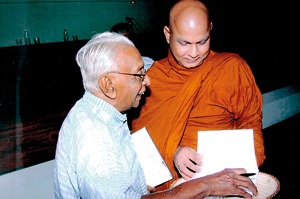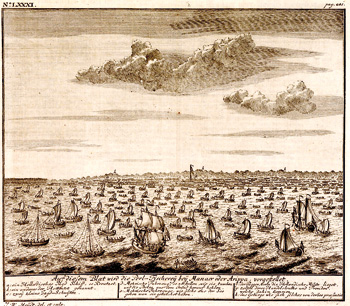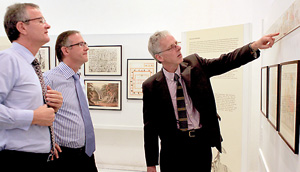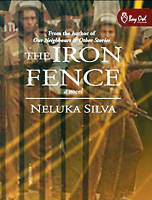September is Literary Month. Prior to the opening of the annual Colombo International Book Fair (now on till September 25) there is always a hive of activity in Colombo. Book launches, awards presentations, literary festivals were aplenty in the past week or two.
The SLFI was the venue of a triple event centred round Dr. Gunadasa Amarasekera, the foremost creative writer amongst us today. The three events were a critical evaluation of the nine books he wrote on the evolution of the Sinhala middle class in the 20th century, the launch of his latest creative work, and the presentation of a bibliography of the articles written by him and on him. Among those present were academics including university dons, writers and book publishers. But there should have been a bigger audience. It's a pity that today's undergraduates don't realise the value of such an occasion, as highlighted by Professor K. N. O. Dharmadasa.
 |
| Gunadasa Amarasekera presenting his latest book to Ven. Tiricunamale Ananda Anu Nayake |
It was good to see Amarasekera quite lively and agile. I could picture him during the Peradeniya campus days in the early fifties. He hasn't changed much except for the grey hairs he is sporting. He is still very active continuing to write.
His latest work – 'Amathaka vu urumaya - Kavandhayata hisak' ('The forgotten heritage - A head for a headless body') – is another thought-provoking piece of writing. He has intended it primarily as a guide to the nine volumes of his long novel. He explains that a novel is a creation by a scholar to expose his vision of society and those who live in it. Often the ideas and opinions expressed by the writer may not be relevant to the contemporary reader. That is why we need literary critics, he says.
Amarasekera laments that it is quite clear from the type of critical evaluations in the newspapers that there are no high calibre critics. Realising this lapse Martin Wickramasinghe wrote 'Navakathaanga saha Viragaya'. If that was the situation then, one can imagine the need for such a work in today's context, Amarasekera says. Pointing out that his present work is an attempt to discuss the author's thinking on the opinions expressed in the novel, he hopes that by his effort some sort of guidance would be provided.
After a few words about his new effort, Amarasekera recited a verse he has written dedicating the book to Ven. Tiricunamale Ananda Anu Nayaka Thera before presenting the first copy to him. The Ven. Thera, he said has won his admiration as a true disciple of the Buddha.
Not many of us realised that over a period of 26 years, Amarasekera had done a comprehensive coverage of Sri Lanka's societal development from the latter part of the 19th century through the 20th century. We had read Martin Wickramasinghe's trilogy – Gamperaliya, Yuganthaya and Kaliyugaya relating the story of the rise of the upper class – a by-product of western influence. We enjoyed Lester James Peries' cinematic creations based on them. Amarasekera's was an attempt to unravel the changes that occurred after that.
He wrote nine books to cover what can be termed the contemporary history of Sri Lanka. Starting with 'Gamanaka mula' (1984), he wrote 'Gam dorin eliyata' (1985), 'Ini mage ihalata' ( 1992), 'Vankagiriyaka' (1993), 'Yali maga vetha' (1993), 'Duru rataka dukata kiriyaka' (2001), 'Gamanaka meda' (2006), 'Ataramaga' (2009) and finally 'Gamnaka aga' (2010). In short, as the titles suggest, the story of a journey from beginning to end.
The head of Visidunu Publishers, Gevindu Kumaratunga told the audience that he hopes to publish the entire collection as one book next year since the series is now complete. It will really be a boon to literary fans.
Bibliography
The compilation of the bibliography of Amarasekera's publications is indeed a well deserved tribute by the Martin Wickramasinghe Trust. This laudable project is the work of the experienced writer Nuwara Eliye Hemapala who has put his long experience in the Department of Government Archives to good use.
The bibliography starts with an abridged life sketch of Amarasekera, ideal for quick reference. Included in the bibliography are details on publications, feature articles and other printed material written by Amarasekera between 1950 and 2011. It's thus an up-to-date collection of data extremely useful for research work. Also included are writings about him.
The bibliography covers both Sinhala and English articles. It is complete with an alphabetical index, an author index and a book index as well.
Amarasekera showed his appreciation of this effort with a broad smile and a word of thanks as Dr Ranga Wickramasinghe handed over the first copy of the bibliography both in printed form and in a CD, on behalf of the Martin Wickramasinghe Trust.
Snapshots from ‘A Return to Sri Lanka’
Now on at the Lionel Wendt
Pearls originating from the Sri Lankan side of the Gulf of Mannar were much sought after, from as early on as the period of the Roman Empire, This fascination with Sri Lankan pearls lasted through the ages, right into the colonial period of Sri Lankan history. Thie image above and others like it record the initial impact that Sri Lanka had on its early colonial visitors.
 |
| JOHANN WOLFFGANG HEYDT (AFTER ARENT JANSEN), The pearl fleet at Mannar, c. 1735 BL X.527 (81) (The original artefact can be found at the British Library.) |
These can be found under the section titled Early Impressions at A Return to Sri Lanka: an exhibition of images of Sri Lanka from British Collections (1640 – 1900) on in Colombo till September 28 at the Lionel Wendt Gallery.
This exhibition draws maps, manuscripts, illustrations, early photographs and paintings of Sri Lanka from several distinguished British institutions —principally the British Library, the Victoria and Albert Museum and the Natural History Museum – as well as the National Museum (Colombo) to bring a selection of very rare material to a Sri Lankan audience for the first time.
The exhibition will also visit Jaffna, Kandy and Galle and is co-curated by British and Sri Lankan curators. It is produced in partnership between the British Library and the British Council (Sri Lanka), with funding provided by the World Collection’s Programme.
Admission is free and information is available in Sinhala, Tamil and English at all exhibition sites.
 |
| British Council Country Director Tony Reilly, British High Commissioner John Rankin and Lead Curator Visual Arts British Library John Falconer at the opening of the exhibition on Thursday. Pix by M.A. Pushpa Kumara |
 |
Books corner
Neluka’s new novel ‘The Iron Fence’ out
The first version of Neluka Silva's novel, 'The Iron Fence', was shortlisted for the Gratiaen Prize in 1998. Now, over a decade later, it's been revised and has just been released under the Perera -Hussein Bay Owl imprint. It is the story of four young university students, caught up in the J.V.P crisis of 1988/89. "I was a student during that period," says Neluka, explaining that she wanted to go back to this time and put down some of the experiences she went through while at university.
Against the backdrop of this "very turbulent, very uncertain" period, Neluka explores two romantic relationships. Despite its inspiration in real life events, the book is not autobiographical: "Though I went through that time in university, I am not the protagonist," says the author, adding "though people may think that I am."
A Professor of English and head of the Department of English at the University of Colombo, Neluka is also the founder-director of Kids @ Play, a children's theatre group. Her work was published in the children's anthology 'Milk Rice' and she wrote 'The Rolled Back Beach - Stories from the Tsunami' with Simon Harris.
She is also the author of 'The Gendered Nation: Contemporary Writing from South Asia' (Sage 2004) and a collection of short stories titled 'Our Neighbours and other stories' (Vijitha Yapa Publications 2009).
‘The Iron Fence’ priced at Rs. 900 is available at the Perera Hussein stall at the Colombo Book Fair.
From travels of Japan
to travails
Soon after releasing a book on his travels in Japan, well known writer Saman Athaudahetti has once again used his experience gathered after the terrible tsunami and nuclear disaster that hit Japan in March this year, to publish another book.
The first Sri Lankan journalist to visit the disaster-hit area he used the opportunity to talk to victims and his new book titled, ‘Ganbaroh Nippon’, is based on the series of articles Athaudahetti wrote for the ‘ Lankadeepa’ newspaper.
The book is an eye-witness account of how the Japanese people were affected by the devastating tsunami, how they coped with the difficulties they encountered on a day-to- day basis and how hard they are trying to recover and rebuild their communities.
The author of several books, the most popular of them being, “Wandering with Pleasure along Hanamichi” - a collection of travelogues on Japan.
Both his books on Japan will be available for sale at the Colombo International Book Fair now on at the BMICH. |






